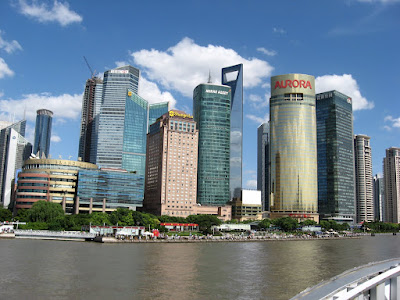
Pudong: Shanghai's Pudong district has perhaps the most amazing skyline in Asia. Pudong is the southeastern part of the central city, across the river from the Bund and Old Town, where the financial district has taken root and built some stylish skyscrapers. (Note the blue skies of my first two days here!)



Practically the first thing I did on arrival, after stowing my bags at the hotel and getting measured up for tailor-made shirts at South Bund Fabric Market, was to take the Huangpu River sightseeing cruise, which displays the best skylines of Shanghai on both sides of the river. Still, Pudong is best experienced firsthand from the Lujiazui circular pedestrian overpass with some great views of the CBD.


The tall building with the square hole in it you see in the top photo is the Shanghai World Finance Center, where you can visit the observation "deck" (actually completely glass-enclosed) for 150 yuan.


This was my view while dining al-fresco at Blue Frog (excellent "mixed grill" for 105 yuan, and they threw in a free Tiger draft!):

The Bund: Britain defeated China in a pair of military contre-temps called the Opium Wars in the mid-1800s. After that time, China was ripe for European domination and exploitation: a period still tangible in the architecture of the French Concession and the Bund--the building styles of colonial and federalist solidity, massive in scale and purposely grand.




The Shanghai Art Museum (in People's Square and site of Kathleen's 5 restaurant) was once the clubhouse of the foreigner-only racing club, back when People's Park was a horseracing course. That's it on the left, of course:

Long-tang, French Concession: City Hotel, where I stayed, is in the French Concession (the French bite of the Chinese pie during the apportioning of Shanghai after the Opium Wars), where long-tang and shinkumen houses are still prevalent. Long-tang are really just the alleys between rows of shikumen. (I wrote a whole post about shikumen here.) Initially, in the late 1800s, these houses, which combine European architecture with traditional Chinese values, were held by rich Chinese families or French. After 1937, the brutal Japanese invasion, many were torn down, or bombed out, and divided up into boarding houses. I don't know what happened to them during the Cultural Revolution, but today some of them have been reborn as small-scale museums (espeically if a famous figure lived there), haute couture boutiques or ... boarding houses.




In sum, Pudong has the Mother of All Asian Skylines, but Puxi, the northwest side of Shanghai, encompassing the Old City, the Bund and the French Concession, has the historic city. Both are worth visiting, both have fine restaurants, both have good shopping--and the view of each may be best from the other side!










2 comments:
Really enjoying seeing all this.
Kinda makes you miss China, huh?
Post a Comment